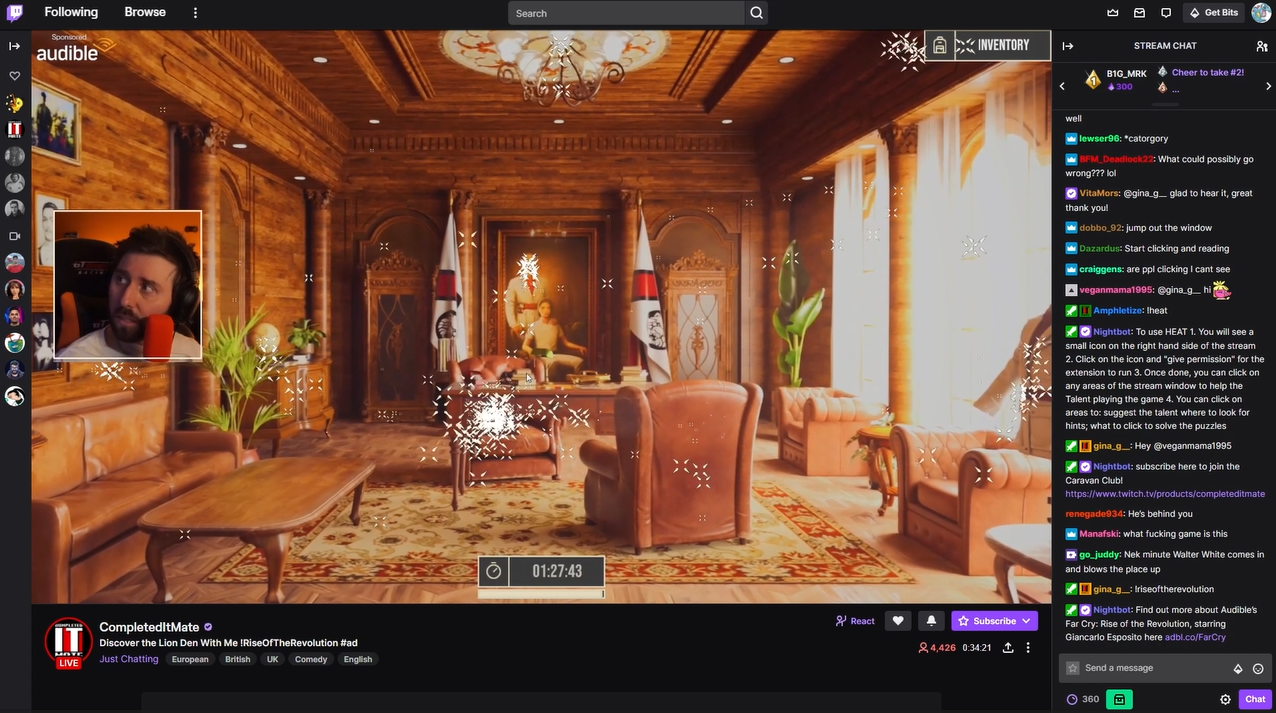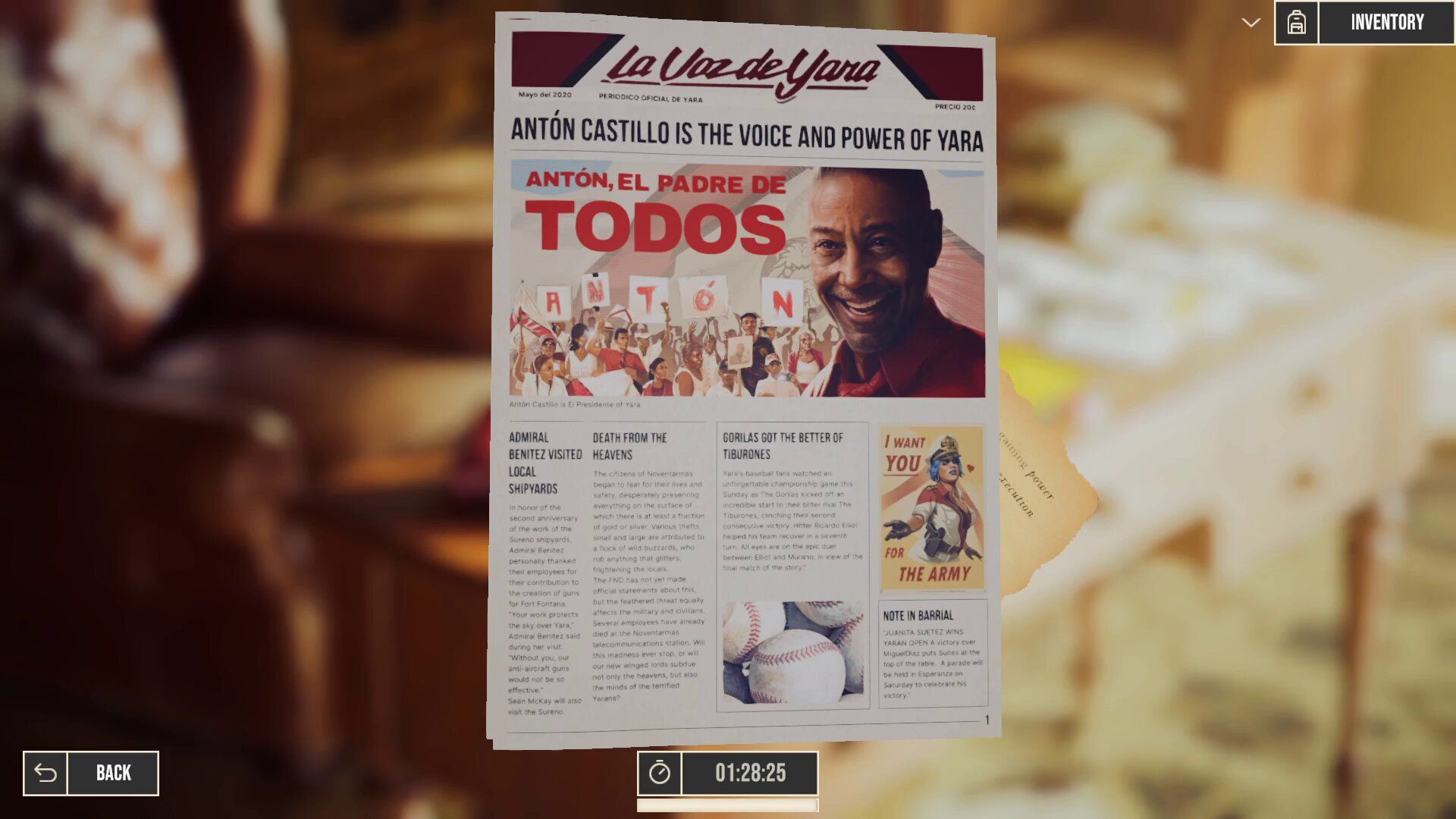Far Cry 6 x Twitch: Interactive Escape Room Experience
In collaboration with
"I think that a new kind of experience has just been born." - Wojciech Walkusz, Project Manager, Le Polish Bureau
BACKGROUND
To celebrate the audiobook series "Far Cry 6: Rise of the Revolution," narrated by Giancarlo Esposito, Twitch, Audible, and Le Polish Bureau collaborated to create an immersive escape room experience. It was brought to life through Twitch live streams hosted by influencers, and filled with mind-bending puzzles. Through our innovative approach and dedicated technological solutions, we were able to actively engage the audience, turning them into active participants.
CHALLENGE
The primary goal of the project was to generate awareness of the Far Cry 6 story among a new audience while maintaining engagement with existing players through a deep dive into the character backgrounds that influenced the game. Given Twitch's prominent position as the premier live streaming platform dedicated to video game streaming, we needed to ensure that the visual quality of the experience as well as its interactivity and stability prove equally unrivalled.
EXECUTION
Twitch invited five popular influencers who actively stream on the platform. While they were aware that a digital escape room game would be part of the stream, they were not given the opportunity to solve the puzzles in advance. Additionally, we asked the streamers to keep their viewers in suspense until the actual streaming moment, only revealing the surprise escape room experience on the designated dates. This approach resulted in five distinct and captivating streams played on Twitch, hosted by CompletedMate, Yogscast, Jericho, Anna Chess, and ItsHafu.
The narrative unfolded from the perspective of a rebel fighter assigned with infiltrating Anton Castillo's infamous office, searching for clues, uncovering his past, discovering secrets, and witnessing his rise to power. However, we wanted to ensure that the viewers didn't simply passively watch the streamers navigate through the exciting riddles. We aimed to actively involve them as players and encourage their engagement with the tasks at hand.
GAMEPLAY AND PUZZLES
Central to the success of the escape room experience was the creation of great gameplay and intricate puzzles. The puzzles were thoughtfully designed to challenge the streamers' and audience's problem-solving skills and immerse them in the captivating world of Far Cry 6. Striking the right balance of difficulty was a significant challenge. We aimed for a live stream duration of 1.5 to 2 hours, ensuring that the puzzles were neither too difficult, causing frustration, nor too easy, leading to quick completion and unsatisfied viewers.
INNOVATIVE USE OF TECHNOLOGY
To empower viewers as active players, we implemented technological changes and rebuilt tools. The first enhancement was the heat map extension, enabling viewers to interact by clicking on their screens. This generated visible marks for both streamers and other viewers. By capturing real-time data on the most clickable spots, we curated a ranking system that highlighted the top five points of interest. This innovative approach enabled streamers to embrace a collective decision-making process, guided by viewers' suggestions for their next actions, locations to explore, and uncovering hidden objects within the game.
Furthermore, we created a bespoke chat analysis tool to address puzzles requiring specific word or number combinations. Streamers prompted viewers to input these combinations in the chat, and we analyzed its contents, displaying the results as percentages on the screen. This valuable information empowered streamers to make decisions based on the majority viewer score, enhancing the interactive experience.
PRODUCTION PERSPECTIVE
Our project's most remarkable achievement was completing it within an impressively short development time of just 12 weeks. One of the key challenges we faced was ensuring a seamless broadcast experience for the streamers. We tackled the task of remotely configuring everything on the streamers' machines, providing comprehensive explanations of the procedures involved. During the live broadcasts, we offered continuous support and assistance to ensure a smooth and successful streaming experience.
To elevate the production quality, we harnessed Unity technology, specifically the High-Definition Render Pipeline. It enabled us to leverage high-quality assets, resulting in a visually stunning experience. For instance, when recreating the throne room of the game's main character, we utilized an immersive 8K 360-degree video. However, due to the demanding nature of this video format, only a limited number of machines could handle it seamlessly. To overcome this challenge, we implemented an external tool called AVProVideo, which efficiently compressed the video while maintaining playback functionality. This strategic solution allowed us to deliver captivating 3D visuals that enhanced the overall immersive experience for our audience.
To achieve our technical vision, we employed a multi-layered video approach, embedding assets and puzzles within the primary video framework. Our primary tool for orchestrating this intricate setup was cinemachine, a powerful tool within the Unity engine that facilitated seamless transitions between different layers of content. Moreover, we incorporated 3D sound technology to intensify the immersion by simulating the sensation of being surrounded by guards and enemies. This created a gradual buildup of tension throughout the game, further enhancing the overall experience.
During the live streams, the final result was a seamless blending of various elements. We integrated the gameplay, multi-layered graphics panels, Twitch's official layout, branding, and advertisements. Additionally, we introduced interactive extensions that provided real-time feedback, responding to the viewers' activities. These interactive elements further heightened the engagement and allowed for a more dynamic and immersive experience for all participants.
TECHNOLOGY USED:
- Unity Engine
- High-Definition Render Pipeline
- AVProVideo
- Cinemachine
- Twitch Listener
- Heat Map Extension
- OBS Studio
- Streamlabs OBS
- Stream Deck (hardware)
RESULTS
LePB created a kind of the first interactive game, played only five times on the streaming service Twitch. Through the creative approach and technical solutions, we activated over 60,000 participants and turned them into active players. The average viewing time was over 1,5 hours, during which users were actively engaged in the solving of given tasks. Because of it, we initiated a new discussion about the future of streaming.









